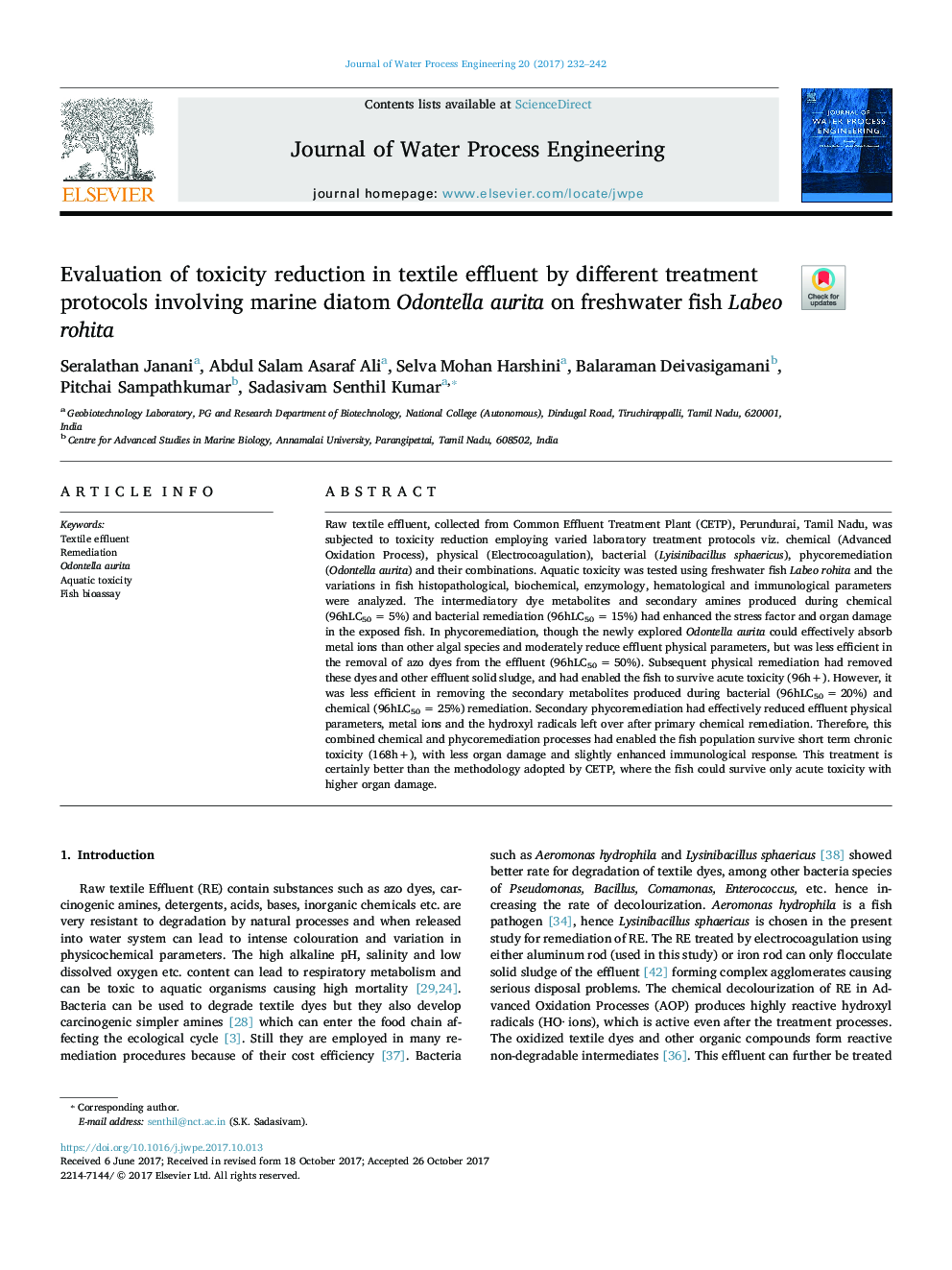| کد مقاله | کد نشریه | سال انتشار | مقاله انگلیسی | نسخه تمام متن |
|---|---|---|---|---|
| 6672065 | 1427552 | 2017 | 11 صفحه PDF | دانلود رایگان |
عنوان انگلیسی مقاله ISI
Evaluation of toxicity reduction in textile effluent by different treatment protocols involving marine diatom Odontella aurita on freshwater fish Labeo rohita
دانلود مقاله + سفارش ترجمه
دانلود مقاله ISI انگلیسی
رایگان برای ایرانیان
کلمات کلیدی
موضوعات مرتبط
مهندسی و علوم پایه
مهندسی شیمی
مهندسی شیمی (عمومی)
پیش نمایش صفحه اول مقاله

چکیده انگلیسی
Raw textile effluent, collected from Common Effluent Treatment Plant (CETP), Perundurai, Tamil Nadu, was subjected to toxicity reduction employing varied laboratory treatment protocols viz. chemical (Advanced Oxidation Process), physical (Electrocoagulation), bacterial (Lyisinibacillus sphaericus), phycoremediation (Odontella aurita) and their combinations. Aquatic toxicity was tested using freshwater fish Labeo rohita and the variations in fish histopathological, biochemical, enzymology, hematological and immunological parameters were analyzed. The intermediatory dye metabolites and secondary amines produced during chemical (96hLC50Â =Â 5%) and bacterial remediation (96hLC50Â =Â 15%) had enhanced the stress factor and organ damage in the exposed fish. In phycoremediation, though the newly explored Odontella aurita could effectively absorb metal ions than other algal species and moderately reduce effluent physical parameters, but was less efficient in the removal of azo dyes from the effluent (96hLC50Â =Â 50%). Subsequent physical remediation had removed these dyes and other effluent solid sludge, and had enabled the fish to survive acute toxicity (96h+). However, it was less efficient in removing the secondary metabolites produced during bacterial (96hLC50Â =Â 20%) and chemical (96hLC50Â =Â 25%) remediation. Secondary phycoremediation had effectively reduced effluent physical parameters, metal ions and the hydroxyl radicals left over after primary chemical remediation. Therefore, this combined chemical and phycoremediation processes had enabled the fish population survive short term chronic toxicity (168h+), with less organ damage and slightly enhanced immunological response. This treatment is certainly better than the methodology adopted by CETP, where the fish could survive only acute toxicity with higher organ damage.
ناشر
Database: Elsevier - ScienceDirect (ساینس دایرکت)
Journal: Journal of Water Process Engineering - Volume 20, December 2017, Pages 232-242
Journal: Journal of Water Process Engineering - Volume 20, December 2017, Pages 232-242
نویسندگان
Seralathan Janani, Abdul Salam Asaraf Ali, Selva Mohan Harshini, Balaraman Deivasigamani, Pitchai Sampathkumar, Sadasivam Senthil Kumar,